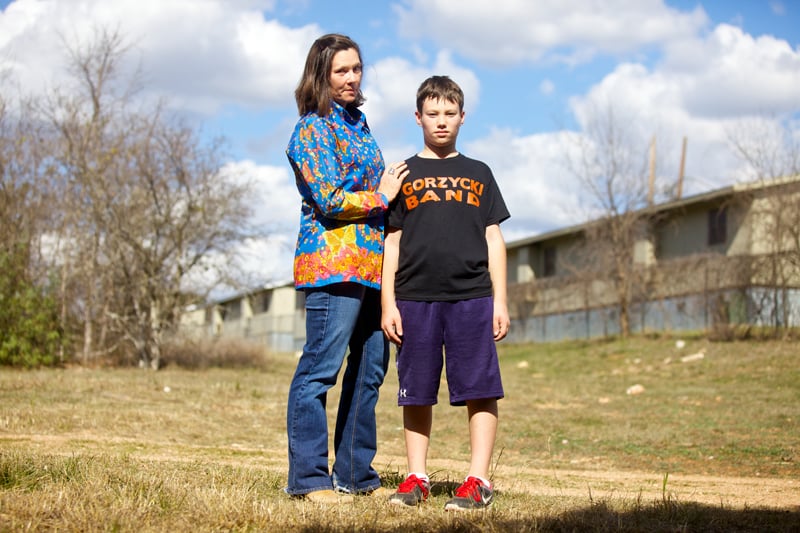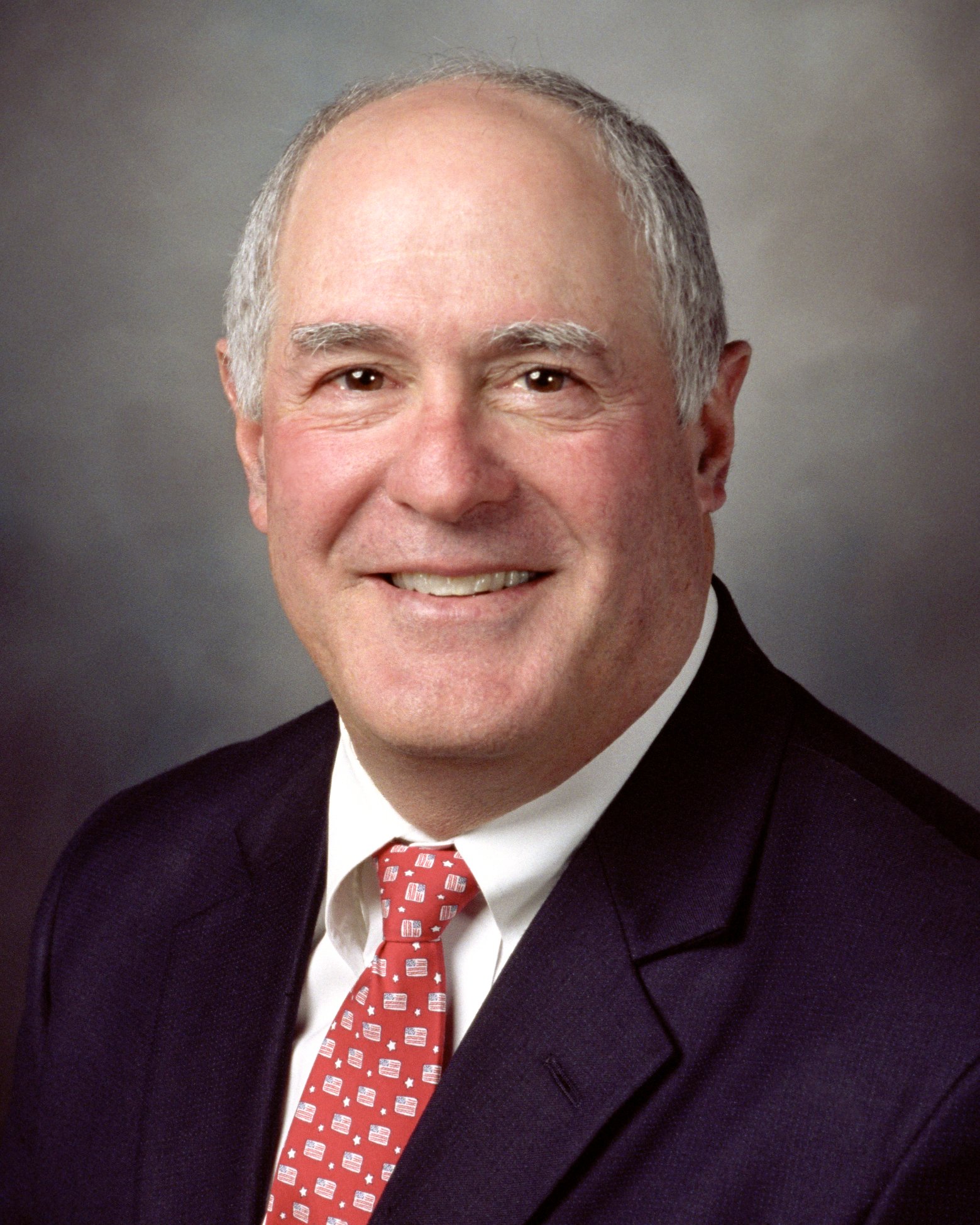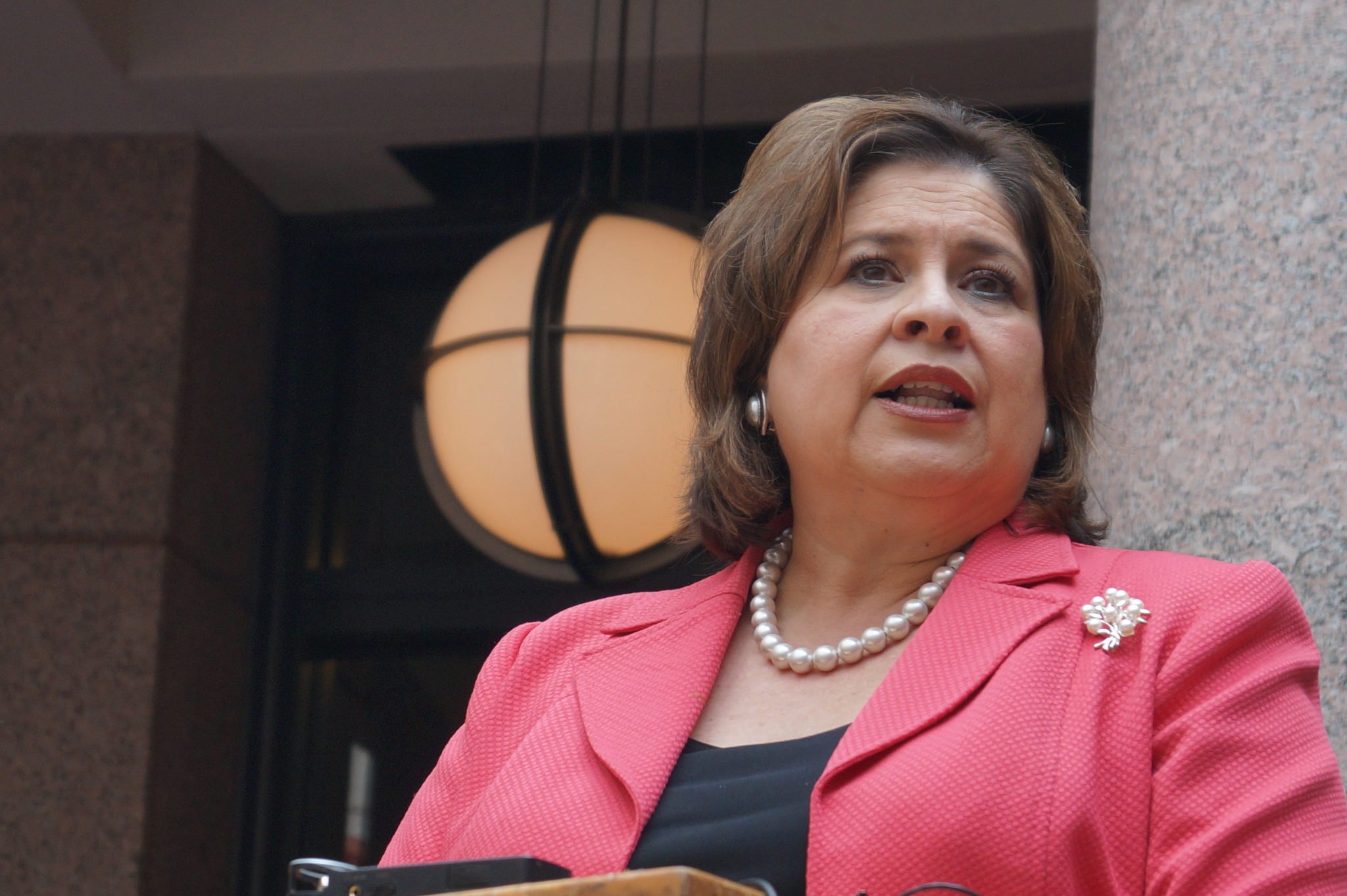
Testing the Limits: A Texas Mother’s Radical Revolt Against Standardized Tests

A version of this story ran in the March 2013 issue.
It’s a warm February afternoon, and 10-year-old Christopher Chamness is tromping through the woods behind his elementary school. In a T-shirt, shorts and baseball hat, he navigates a dusty path lined with cedar and cactus, lingering over the novel sight of fresh animal droppings. At a bend in the trail, he finds a stone-walled retention pond and crouches at the edge to peer in.
His mother Edy trails behind him in a long-sleeved blue butterfly-print shirt and jeans. Looking around, she tells stories about the hours they’ve spent back here together. They’re good memories, and she enthusiastically recalls the biology teachers and naturalists she’s invited to join their walks to explain the evidence of erosion and drought, or to point out remnants of fences from the old Circle C Ranch, which was here long before a subdivision by the same name popped up in far South Austin.
“This is where the really great learning begins,” she says. “In your backyard.”
These were the lessons she crafted for her son—on wildlife, botany and geology—on weekdays in November while Christopher’s classmates sat in a room just a few hundred feet away, filling in answers on standardized tests. Day after day she’d pull Christopher from class and walk across the playground and through the back fence, returning a few hours later when the tests were done.
Edy Chamness and her son were staging an extreme protest against Texas’ regimen of standardized tests and school accountability. It’s a system, she says, that has spiraled out of control, taking over classrooms and inflicting needless stress on little kids. Those dusty strolls behind the school may not have looked too rebellious, but then civil disobedience often doesn’t.
The reasoning behind opting out is simple: If politicians and school officials want data on student performance, they need students to provide it. If enough students quit cooperating, politicians will have to find another way to measure school performance—without tests. The way Chamness sees it, teachers, students and parents have been shut out while politicians and test companies dictate what happens in schools. By opting out of testing, she figures she’s elbowing her way back into the conversation.
Chamness is a former teacher who spent 13 years in Lockhart and Eagle Pass elementary schools. “I had to work in small towns where I was free to teach,” she says. She believes in hands-on learning—field trips, gardening, big class projects—and bristled at the test-first culture creeping into Texas schools. She left teaching in 2002, the year her son was born. The next year, for the first time, Texas third-graders were required to pass a reading test to advance to fourth grade.
Since then, testing has only continued to grow in Texas and nationwide. Test scores now partially determine teachers’ pay, superintendents’ bonuses, even home property values—things tests were never meant to measure. But while plenty of people agree with Chamness that testing culture has taken hold of schools, her means are controversial.
Chamness and the Facebook group she started in 2011, Texas Parents Opt Out of State Tests, occupy the radical fringe in a broad revolt against the state’s testing regimen. Nationwide, a “United Opt Out National” group provides flyers for parents who want to stage their own opt-out protests, and even organized an “Occupy DOE” rally outside the U.S. Department of Education last year. But nobody counts how many parents actually follow through with plans to opt out, and schools are disinclined to draw attention by publicizing totals. Opt-outers are simply marked as absences on test day. The closest thing to a mass opt-out took place last December in Seattle, where high school teachers, not parents, refused to give a district-mandated test. They’ve become heroes within the anti-test movement.
Opting out of tests carries severe consequences. Schools face state and federal sanctions if too many students miss the test. In higher grades, students can’t graduate if they fail or refuse the tests. Even the most vocal opt-outers—former teachers, usually, who wrestle mightily with the decision—often settle for symbolic half-measures when faced with the reality that their protest could harm their children’s futures.
So far, Chamness hasn’t pulled her son from any tests required to advance to the next grade. They have boycotted state tests and so-called benchmark tests—practice tests given by the Austin school district, not the state—meant to prepare students and gauge them before the all-important end-of-course state test. Chamness just hopes Texas will back off its test regime before her son gets much older. But she’s absolutely sure of one thing: Christopher has learned more on their opt-out days than he ever would from a test.
Texas’ grand love affair with testing began modestly in 1979, when the Legislature first required reading, writing and math exams for third-, fifth- and ninth-graders. The test, called TABS, was meant as a diagnostic tool for schools to ensure their students were learning the basics. Over the years, though, politicians began demanding more tests and higher scores to prove schools were performing. New versions of the test—TEAMS, TAAS and TAKS—followed in each of the next three decades, each test harder than the last. Students had to pass tests to graduate, and schools that didn’t maintain a good passing rate could be closed. Supporters said it put pressure on schools in low-income neighborhoods that had never faced high expectations. In 2002, George W. Bush took Texas’ model and applied it nationwide with his signature No Child Left Behind law, requiring high-stakes standardized testing in every state.
Schools adjusted to keep up. Poor schools, which tended to score lower than rich schools, responded by drilling students to prepare for the test. Teachers of subjects that weren’t tested, like social studies and art, were told to focus on reading practice. Big class projects became a waste of time. Schools bought and developed test-prep materials geared toward state exams, and spent days giving their own “benchmark” tests between the state exams. Many school districts around the state now devote around 40 days a year to testing and test prep.
Many teachers resisted the tests, especially in black and Latino communities, where students were more likely to be deprived of a diploma because of low scores on the state test. In 1997, seven such students backed by the Mexican American Legal Defense and Educational Fund sued Texas over the testing system, but lost.
Texas’ latest test, STAAR, is bigger and tougher than anything the state has tried before. Created by the Legislature in 2009, STAAR represents a huge expansion of testing in high school, requiring students to pass 15 end-of-course exams to earn Texas’ recommended diploma—well more than any other state in the country. At the end of each of the 15 core high school courses, students must take, and perform well on, a state test. And for the first time, standardized tests would not just measure school performance, but account for 15 percent of a student’s grade in a particular class. That “15 percent rule” posed a threat to even high-scoring college-bound students, who found their GPA and class rank now tied to state-issued tests. As STAAR rolled out in the 2011-2012 school year, the ranks of anti-test activists swelled with wealthier, more plugged-in parents—folks more likely to be heard by state leaders, with the means and time to travel to the Texas Capitol to protest or lobby lawmakers (or even to opt out, and spend all day teaching and entertaining their kids).
Former Texas Education Commissioner Robert Scott came to refer to these parents as the “Mothers Against Drunk Testing,” and in late January 2012, he furthered their cause. During a speech to school administrators, he said the state’s testing system had become a “perversion of its original intent.” Days later, speaking to the State Board of Education, he kept the drumbeat going: “You’ve reached a point now where you’ve got this one thing that the entire system is dependent upon,” he said. “It is the heart of the vampire, so to speak.”
Within a few months, Scott announced he’d be leaving his post, headed for an Austin law firm. But for the droves of anti-testing activists he’d inspired, it was just the beginning. Edy Chamness was one of them.

Chamness first thought something might be wrong when Christopher lodged a pencil eraser in his ear. On the resulting ride to the doctor’s office, she divined that his third grade class was boring him to death. She visited his class, where she found her worst teaching nightmares brought to life: hours of worksheets and test prep, no hands-on lessons. She had Christopher transferred to another school, but shortly after, while talking with Christopher’s principal, she learned a week of benchmark testing was coming up. She didn’t know what else to do.
“I said, ‘We’re not taking those tests,’ and [the principal] goes, ‘I just want to give you the heads-up that there’s designated makeup days too, so if you’re not going to take the tests on Tuesday and Wednesday, you probably don’t want to come for the test prep rally on Monday. And don’t come in on Thursday or Friday, or else the school will be obligated to administer the tests on makeup days.’”
Chamness made plans to fill a week of opt-out days, as she’s done for benchmark weeks the past two years. She and Christopher have gone to museums, taken those long nature walks behind the school, even scheduled trips to the dentist on test days. “That was really educational,” she says. “To have the hygienist take the time with the children and talk about their teeth and aspects of their oral hygiene, that was so much better than any testing could’ve been.”
By Christopher’s fourth-grade year, Edy began handing out flyers to his teachers that quoted research into the bad effects testing had on kids, to help explain to his teachers why he was missing tests.
“Just about the time I got really mad,” she recalls, “Robert Scott made that speech. And I went, ‘Hallelujah, somebody in a position of leadership is denouncing this junk.’ … So I probably did something I shouldn’t have done.” She copied email addresses for every fourth-grade parent in the school, and sent them a message from “Texas Parents Opt Out of State Tests.”
“Dear Parent,” her email began, before listing the benchmark testing days scheduled for the year. Then she asked, “What is the purpose of all this testing? Why must our children’s education be constantly interrupted and compromised by the standardized-testing industry?” She quoted a passage from the Texas Education Code that says parents may remove their children from any school activity that “conflicts with the parent’s religious or moral beliefs.” She left out the line, added in 2005, that said the law didn’t apply to testing.
Her life as an anti-test radical had begun. She was in league with new parents’ groups like Texans Advocating for Meaningful Student Assessment—but Chamness remained apart. The other groups picked up major momentum speaking at community events around the state, drawing big crowds at the Capitol. And while speakers took turns at the podium, Chamness roamed the crowd with her opt-out signs.
“There’s a lot of people out there who want to help kids, but they’re trying to do it through the political process, like introducing bills, or moratoriums—I don’t know.” That isn’t quite where Chamness fits in. “People don’t like civil disobedience. … Even my own mother says, ‘Well aren’t you just teaching your son to buck the system?’ Yeah, I guess I probably am.”
That system Chamness is teaching her son to buck? Sandy Kress is probably its biggest proponent. An architect of Texas’ accountability system in the late 1990s, Kress went on to help Bush design No Child Left Behind. He’s a staunch defender of accountability in schools, and an influential Austin-based lobbyist whose clients include Pearson, the company with the half-billion-dollar contract to develop and manage STAAR. He often writes op-ed pieces warning against a return to the days when bad schools could coast by without pressure to improve.
So it’s a little surprising when he returns a call to discuss the opt-out movement and straightaway volunteers this: “There are plenty of testing practices that I think are absurd. I’ve been a parent of a child in a public school who was benchmark-tested to death. I get those concerns. I kind of wonder why parents aren’t protesting the benchmark testing.
“What I don’t get so much,” he says, “is this sort of civil disobedience or protest of an end-of-year test.” Without that, he wonders, how can parents really trust the letter grades their kids bring home? Writing samples and class work only tell you so much. “I want to know too, on an objective measure, how they did against the state standards, particularly in a time of inflated grades.” Kress wonders how districts can get away with forcing students to endure weeks of benchmark, or practice, testing. With so much depending on the state test—the school’s ratings and perhaps its very existence—districts have argued the system requires them to make sure students are well practiced at test-taking. But Kress isn’t impressed. “I think it’s a poor excuse,” he says.
Julie Westerlund, a Texas State University professor who helps Chamness with her Facebook group, says it’s not so simple to separate benchmarks from the STAAR. “The districts’ hands are tied. They, of course, are trying anything they can to get scores up, and so it’s natural that they will have benchmark testing,” she says. She’d prefer Texas used diagnostic tests, given when there’s still time to help kids with what they’re missing. “The STAAR tests are high-stakes tests, they’re punishing tests.”
Brandon Moore, a former teacher who moved from Minnesota to get his doctorate in education at Baylor, says the punitive nature of the test—and the toll it took on his daughter—is what got him thinking about opting out.
“My oldest would come home crying, saying, ‘Oh my God, I’m so stressed about this test,’” he says. “That’s when I was like, wait a minute, something is wrong here.”
At his daughter’s school last year, Moore learned that school officials set aside Wednesdays for STAAR prep—benchmark testing, lessons about how to find right answers and make good guesses. Then test prep was rescheduled for two hours after lunch every day. Opting out of just the benchmark tests wasn’t an option—if his daughters skipped the testing hours, they’d be given the test when they got back. “We just decided that we’ll go for the gusto and take them out of the big one.”
Moore says he and his wife debated their choice until the night before the state test. Then he took his daughters to work with him the next day. School administrators tried to convince him to let his daughters sit for makeup tests. An official from the Texas Education Agency warned that Moore’s older daughter wouldn’t advance to the next grade if she didn’t take the test. In the end, she did take a math test, but Moore opted her out of tests on reading and science.
“The one thing we always said we weren’t going to do is let this negatively affect our kids,” he says. “Parents are justifiably scared to do it, because of all the—I don’t want to say threats—but all the possible negatives.”
As the most visible face of the opt-out movement in Texas, Chamness says she knows all about threats, from school administrators, from other parents, from anonymous strangers on the Internet. When she first told Austin ISD officials that she was pulling her son from benchmark testing, “They were enraged,” she says. “I underestimated how angry that would make them and how threatened they would be by one South Austin mother doing that.”
What Chamness says she wants most of all is to get parents active, to wake them up to what politicians have turned the school system into. “All I really want to do is educate people and let them know what’s going on, so they can make their own decision.”
She recently had that chance with a mother in Richardson, who asked what to expect when she raised the issue of opting out with her local PTA. “I said, expect the worst,” Chamness says. “It’s OK if you’re going to be quiet and silent about not taking the test, but the minute you try and make a spectacle, or even highlight what you’re doing—oh man, they will snuff it out best they can.”
The woman Chamness advised is Josi Lauritzen, a mother of two who grew up in Seattle and moved to Texas a decade ago. She has a fifth-grade son and a third-grade daughter, and worries about how much pressure they feel to perform on the test. She says she’s “pondering” opting out. “It’s bigger than all of us, and it’s hurting our kids,” she says.
Richardson lies geographically and politically between Dallas and its conservative far-north suburbs in Collin County. Lauritzen says she doesn’t agree about much with her tea party neighbors, but they do agree about testing. “I think this is one issue that can change the polarization,” she says.
“The schools are not child-centered. They are performance-centered, for us, so we can put our kids in a school that says it’s ‘exemplary’ or it’s ‘recognized,’” she says. “I would be happy if we just got rid of STAAR entirely.”
State lawmakers aren’t likely to dispense with STAAR, but there are plans to shrink the test this year and to lower its stakes.
Sandy Kress, like others who once staunchly defended STAAR, has been open to scaling it back, allowing that the bill creating the test in 2009 probably “overshot.” He shares the opinion, now common among lawmakers too, that it’s smart to cut back on the number of exams students must pass to graduate. But he wants to see the spirit of the bill left in place.
“It looks like a wild swing to me,” Kress says. “The idea that we would come in and just completely throw it out, completely tear it down and go back to where we were before, doesn’t seem like smart policy to me.”
The first bill passed by the Senate this session would scrap the dreaded “15 percent rule.” Other proposals would cut the number of end-of-course tests to as few as three, create more hands-on career-readiness courses, and rate schools on factors other than just test scores.
None of which quite satisfies Chamness. “Their solutions are just so tiny. And when the system is really profoundly broken as it is, you can’t just tweak it,” she says. “They might reduce a little bit of this problem, but we’re in serious trouble. Only some people believe that opting out is the only way. If there’s another way, you tell me what it is and I’ll do it. … Opting out is the only true way to make anything happen. Sometimes you have to break the law.
“I can’t go back, I can’t pretend it’s not a problem. They’ve all seen testing, most parents out there know that it exists. They’ve seen it hurt their kids. I don’t know how much more they need to be told about it before they’re going to do something.”


